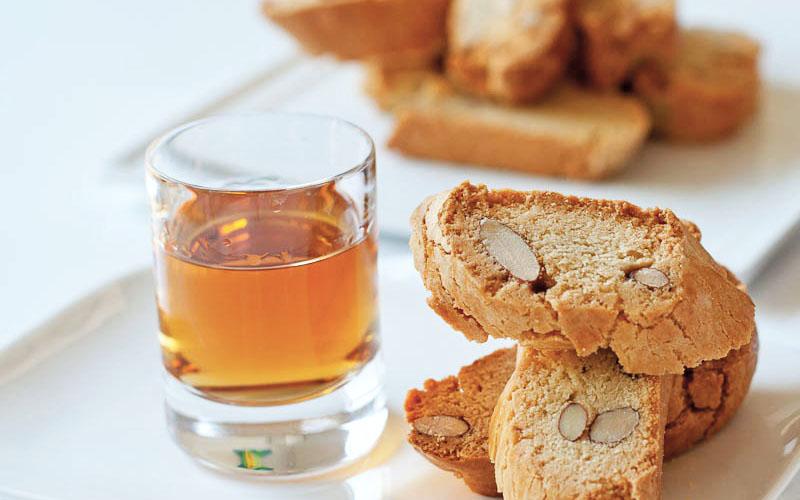Words by Carla Passino and Silvia Donati
From Passito di Pantelleria to Moscato d'Asti, there’s an Italian dessert wine for every occasion.
There is no better way to understand Italy’s complexity than through its wine. The fresh breeze of the sea, the crisp cold mountain air, the penetrating scent of Mediterranean scrubland, the tart sweetness of forest fruits, all make their way into the bottle, creating a huge range of bouquets and flavours that reflects the scenery and quirks of the Italian terroir.
But while this gustatory gamut has long delighted dry wine aficionados from around the world, few people realise that local character emerges just as forcefully in dessert wines, a somewhat overlooked Italian production.
Just take a moscato from Friuli - pale straw in colour, lightly sweet in the mouth, with plenty of acidity to cut through the sweetness - and the same wine made in southern Sardinia - a golden triumph of Baroque-like richness, its honeyed sweetness almost solid in the mouth. The first speaks of cold winters and cool summers, of verdant hills and thick woods; the second is sunshine in a bottle.
Add wine culture and vinification processes to geography and you end up with an infinite variety of dessert wines. Straw wines from the Centre and South, late harvest wines from the North and the Islands, and then noble rot, icewines—there’s an Italian dessert wine to suit every cheese, every pudding and every mood.
To help you choose, we have picked three of the very best.
Moscato d'Asti

Moscato d'Asti, lightly sweet, gently effervescent and low in alcohol, is mainly produced in the hilltop town of Asti (not to be confused with Asti spumante), and in the nearby provinces of Alessandria and Cuneo in the north-western region of Piedmont.
Obtained from the Moscato bianco grape, which is considered the best within the Muscat family of grapes, it takes its name from its earthy musk aroma. It is believed to date as far back as the 1300s. Moscato bianco is in fact considered one of the oldest grapes grown in that area.
As a sparkling wine, Moscato d’Asti used to be a wine that winemakers made for themselves, to be drunk at lunch so that, thanks to its low alcohol content, it would not slow them and their workers down. In the evenings, multi-course meals called for a digestif to clean the palate and prepare it for dessert, and Moscato served that purpose.
Combining sweetness and acidity, it has a delicate but complex aroma, with hints of oranges and dried apricots. It should be served slightly chilled. Go for a DOCG Moscato d’Asti, which is a guarantee of the quality of the product, still made my small producers.
Moscato d’Asti has seen its sales increase by 73% since 2011, and its exports to the United States have soared. It is especially popular among consumers under the age of 45, both because of its affordability and, curiously, thanks to its adoption as the drink of choice by hip-hop culture.
Vin Santo

The name itself is enough to make you want to try Vin Santo. It means Holy Wine and there are several theories as to how it arose. One story has it that, in the Middle Ages, a Franciscan friar used altar wine to save people from the Black Death. Believing it to be miraculous, the Tuscan populace quickly named it Vin Santo.
Another story wants the name to come from none other than Cardinal Bessarion, a Greek scholar who tried (in vain) to reconcile the Orthodox and Roman Catholic churches. At the ecumenical Council of Florence, he tried a glass of sweet wine and declared it to be Xantos - meaning, presumably, that it reminded him of the Greek wine from Xantos. Whatever he really wanted to say, however, got lost in translation, as the Florentines mistook his word for Santo, and the wine became known as Holy.
Be as it may, Vin Santo is certainly fit for saints, or at the very least kings - saints being, hopefully, far beyond the temptations of the palate. Usually made from Trebbiano and Malvasia varieties, it can be incredibly sweet or dry. Grapes are picked and left to dry on rush mats (or hung from the rafters) for a few months before being pressed—the sugar in the grapes concentrates as they slowly turn into raisins. The juice is then fermented and aged for up to ten years in small cigar-shaped barrels that are not completely full. The wine is thus exposed to air, acquiring character and colour.
When ready, Vin Santo is rich golden and viscous, with a scent of apricots and a smooth taste of caramel and nuts. The nutty notes are what make the sweeter Vin Santo perfect with cantuccini - these Tuscan almond biscuits are dunked in the wine, which they soak up beautifully.
But the best, most complex Vin Santo should be savoured by itself to enjoy the miraculous taste that makes it worthy of its name.
Passito di Pantelleria

It is a miracle that this wine still survives. Pantelleria is a tiny island, and wind-beaten - the Arabs, who once ruled this lump of rock between Italy and Africa, called it "daughter of the wind". Picking the grapes in the blowing gales is hard work, and young islanders tend to go elsewhere to find their fortunes anyway. Production has been slowly decreasing in recent years but there is yet hope for the future, in the form of investment from big Sicilian winemakers, and the recent creation of a consortium to save local vineyards.
Let’s root for it, because losing this treasure of Italian oenology would be a real shame. The origins of the Passito are wrapped in the mist of time, but legend has it that the goddess Tanit won Apollo’s love by serving him a cup of the Pantelleria wine - no mean feat, considering that the Olympian god was used to nectar and ambrosia.
Perhaps inspired by the story, one of the world’s greatest womanisers, Giacomo Casanova, used to offer a glass of Passito to the ladies he intended to seduce. But then Passito, made with the aromatic Zibibbo grapes, is good enough to win hearts.
The grapes are picked early, often in August, placed to dry on straw mats under the blazing sun for a few weeks, and turned every day to prevent rotting. They are then pressed, often together with newly harvested grapes, and fermented for a long time. Some winemakers also add raisins at a later stage for a more intense flavour.
This makes a velvety wine with deep amber colour and intense scents of dried figs, apricot and date. In the mouth, it is warm and round, honeyed and intensely sweet. Great with rich Sicilian desserts, but even better on its own.














